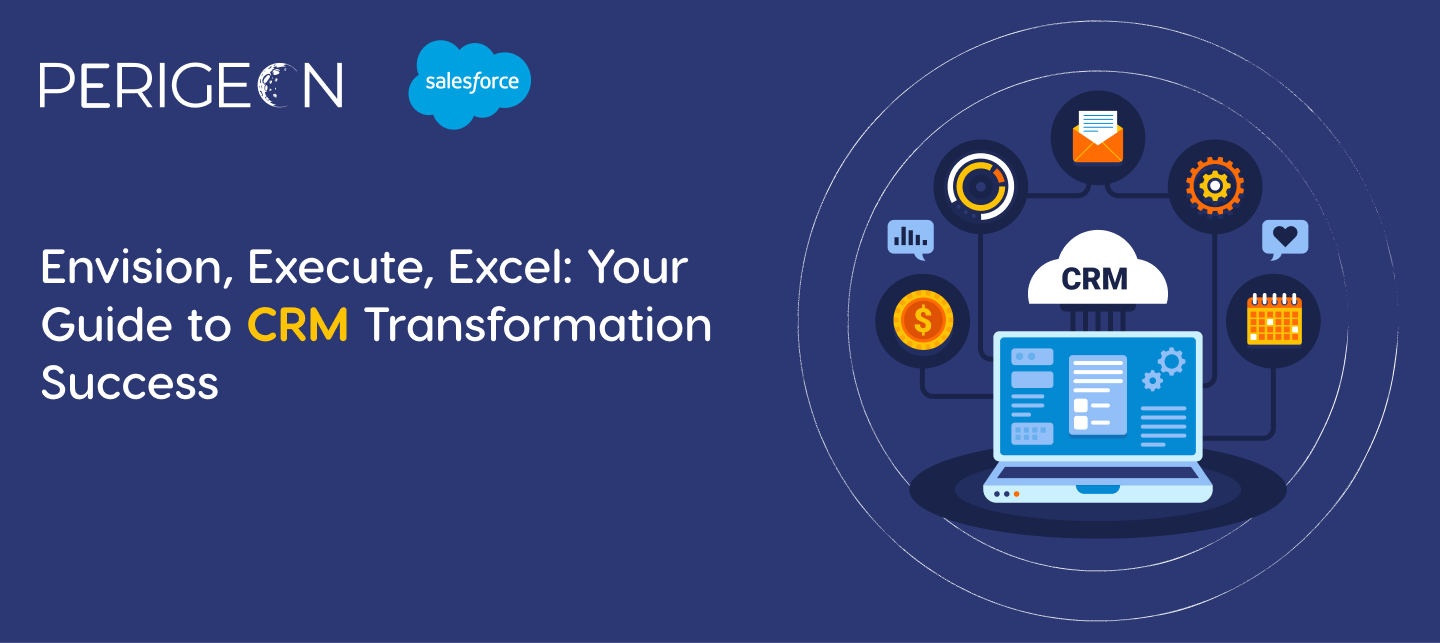CRM transformation is changing how businesses connect with their customers in the digital age. It’s not just about using new software—it’s about completely rethinking customer relationships using modern technology and processes.
Digital tools have fundamentally changed how customers interact with businesses:
- AI-powered analytics provide instant insights into customer behavior
- Cloud-based platforms allow teams to work together seamlessly, no matter where they are
- Automation tools make repetitive tasks and communications more efficient
- Mobile solutions enable businesses to engage with customers anytime, anywhere
To successfully transform your CRM, you need to go through three key phases:
- Envision: Develop a clear plan that aligns with your business goals
- Execute: Implement the right technologies and drive change within your organization
- Excel: Continuously improve and adapt based on insights from data
It’s important that your CRM initiatives directly support your overall business objectives. This alignment ensures that every investment in technology and every change in process leads to real results—whether that’s more revenue, happier customers, or smoother operations.
Think of CRM transformation as building a bridge between what you can do now and what you want to achieve in the future. Each phase of the process makes this bridge stronger, creating better connections between your team, your technology, and your customers. The outcome? An agile organization that’s ready to meet changing customer expectations in a world that’s becoming increasingly digital.
1. Envision Phase: Setting a Clear Vision and Strategy for CRM Transformation Success
A well-defined vision is the foundation of successful CRM transformation. Your vision statement should capture both immediate goals and long-term aspirations, creating a roadmap that guides every decision throughout the transformation journey.
Key Components of an Effective CRM Vision:
- Clear definition of desired business outcomes
- Specific, measurable success metrics
- Timeline for implementation phases
- Resource allocation framework
- Risk assessment parameters
Business alignment is crucial in developing your vision. Your CRM goals must reflect and support broader organizational objectives, such as market expansion or improving operational efficiency.
Strategic Alignment Checklist:
- Map CRM objectives to company-wide KPIs
- Identify departmental touchpoints and dependencies
- Define cross-functional collaboration requirements
- Establish governance structures
- Create accountability frameworks
The strategy development process requires a strong focus on enhancing customer experience. Modern CRM transformation uses data analytics to understand customer behavior patterns, allowing for personalized interactions at scale.
Customer Experience Priorities:
- Real-time response capabilities
- Personalization engines
- Omnichannel integration
- Customer feedback loops
- Predictive analytics implementation
Digital innovation is crucial in optimizing workflows. Your CRM strategy should include advanced technologies that improve operational efficiency and drive revenue growth:
Strategic Technology Integration Points:
- AI-powered automation
- Cloud-based solutions
- Mobile accessibility
- IoT connectivity
- Blockchain security
Revenue growth opportunities arise from strategic planning that focuses on digital modernization. Your CRM transformation strategy should identify specific revenue streams that will benefit from better customer relationship management:
- Increased customer lifetime value
- Enhanced cross-selling opportunities
- Reduced customer acquisition costs
- Improved retention rates
- New market penetration potential
2. Execute Phase: Implementing Technology and Organizational Change for Effective CRM Transformation Execution
The execution phase transforms your CRM vision into tangible results through strategic implementation of technology and organizational changes. This critical stage requires a balanced approach between technical deployment and cultural adaptation.
Technology Infrastructure Implementation
- Deploy cloud-based CRM solutions for scalability
- Integrate AI-powered automation tools
- Establish data analytics capabilities
- Create secure API connections with existing systems
- Set up backup and disaster recovery protocols
Change Management Strategies
- Create dedicated transformation teams
- Develop role-specific training programs
- Design clear communication channels
- Establish feedback mechanisms
- Build support networks across departments
Your execution strategy must address both immediate technical needs and long-term organizational sustainability. A phased rollout approach helps manage risk and allows for quick adjustments based on real-world feedback.
Key Implementation Milestones
- Initial system setup and configuration
- Data migration and validation
- User acceptance testing
- Employee training programs
- Go-live preparation and execution
The execution phase demands careful attention to technical details while maintaining focus on human factors. Your implementation team should include both technical experts and change management specialists working in tandem.
Critical Success Factors
- Regular stakeholder updates
- Clear success metrics
- Responsive support systems
- Documented processes
- Continuous training opportunities
A successful execution phase creates a strong foundation for your CRM transformation by establishing both the technical infrastructure and organizational readiness needed for sustained success. Your implementation strategy should remain flexible, allowing for adjustments as you gather user feedback and encounter real-world challenges.
3. Excel Phase: Sustaining Success Through Continuous Improvement in CRM Practices and Mindset
The Excel phase transforms your CRM implementation into a dynamic, evolving ecosystem. Real-time data analytics serve as your compass, guiding strategic decisions and process refinements across your organization.
Key Components of Excellence-Driven CRM:
1. Data-Driven Decision Making
- Implement AI-powered analytics dashboards
- Track customer behavior patterns
- Monitor team performance metrics
- Measure ROI on CRM initiatives
2. Agile Process Optimization
- Run A/B tests on customer engagement strategies
- Adjust workflows based on performance data
- Identify bottlenecks through process mining
- Scale successful practices across departments
Creating a culture of continuous improvement requires structured approaches to learning and innovation:
3. Regular Innovation Sprints
- Dedicate time for teams to experiment with new CRM features
- Test emerging technologies in controlled environments
- Document and share learnings across departments
4. Cross-Functional Collaboration
- Form innovation circles across teams
- Share best practices through internal knowledge bases
- Create feedback loops between customer-facing and technical teams
5. Skill Enhancement Programs
- Provide ongoing training on new CRM capabilities, such as digital workplace skills
- Develop internal CRM champions
- Encourage certification in relevant technologies
Real-world application of these principles might look like:
“Our sales team noticed declining engagement rates in email campaigns. Through real-time analytics, we identified optimal sending times per customer segment. A/B testing different message formats led to a 27% increase in response rates.”
The Excel phase not only transforms your CRM from a static tool into a competitive advantage but also aligns with the broader digital transformation roadmap. Your organization becomes a learning engine, constantly refining processes and adapting to market changes through data-driven insights and systematic experimentation, thus ensuring sustained success through continuous improvement in CRM practices and mindset.
Lessons Learned from Historical CRM Implementations: Avoiding Common Pitfalls on the Path to Successful Transformation
Historical CRM failures teach valuable lessons about the complexities of digital transformation. Research shows that 50-70% of CRM initiatives fail to meet expectations, creating a roadmap of what not to do.
Common pitfalls that lead to CRM failures:
- Technology-First Mindset: Organizations often rush to implement new CRM systems without considering their existing business processes or user needs
- Poor Data Quality Management: Neglecting data cleansing and standardization leads to unreliable insights and decreased user adoption
- Inadequate User Training: Rolling out complex systems without proper training creates resistance and reduces productivity
- Siloed Implementation: Treating CRM as an IT project rather than a company-wide transformation initiative
- Lack of Clear Success Metrics: Failing to define measurable outcomes makes it impossible to track progress and ROI
Real-world example: A global manufacturing company invested $5M in a new CRM system but saw only 10% adoption rate because they didn’t involve end-users in the selection process and failed to address existing workflow inefficiencies.
Key Learning Points:
- Involve stakeholders from all departments in the planning phase
- Start with process optimization before technology implementation
- Create a robust data governance framework
- Develop comprehensive training programs
- Set clear, measurable objectives aligned with business goals
Companies that avoid these pitfalls and take a holistic approach to CRM transformation see up to 3x higher success rates in their implementations.
Conclusion
The Envision-Execute-Excel framework offers a new way to implement CRM that goes beyond traditional project management methods. It requires a fundamental change in how organizations think, embracing continuous growth and adaptation in managing customer relationships.
Key Takeaways from the Framework:
- Envision: Your vision serves as the guiding light, influencing every decision and action throughout the transformation process.
- Execute: Success comes from the smooth integration of technology, people, and processes working together.
- Excel: Data-driven insights drive ongoing improvement and innovation in CRM practices.
To achieve success in CRM transformation, leaders must be fully committed, teams must actively participate, and a culture that welcomes change must be established. By adopting this framework, organizations can:
- Build stronger customer relationships
- Drive sustainable revenue growth
- Create lasting competitive advantages
- Foster innovation across departments
- Develop agile response capabilities
Your journey towards CRM transformation doesn’t end with implementation; it continues to evolve alongside your business needs and customer expectations. The Envision-Execute-Excel framework lays the groundwork for this ongoing evolution, ensuring your organization remains adaptable, resilient, and prepared to tackle future challenges in managing customer relationships.
Remember: Successful CRM transformation isn’t just about changing systems – it’s about transforming how your organization thinks about and delivers value to customers.






